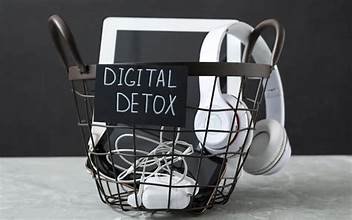
A digital detox refers to a period of time when a person voluntarily refrains from using digital devices such as smartphones, computers, tablets, and social media platforms. The goal is to reduce stress, restore balance, and reconnect with real life — without constant digital distractions.
This doesn’t necessarily mean abandoning technology completely, but rather being more intentional about how we engage with it.
Why We Need a Digital Detox
1. Mental Overload and Burnout
Constant notifications, messages, emails, and endless content can overwhelm the brain. The result? Digital fatigue, mental exhaustion, and decreased focus.
Studies show that excessive screen time is linked to higher levels of stress, anxiety, and even depression.
2. Sleep Disruption
Using screens late at night interferes with melatonin production, making it harder to fall — and stay — asleep.
Blue light from screens confuses our circadian rhythms, leading to poor sleep quality and daytime fatigue.
3. Reduced Productivity
Multitasking between apps, tabs, and platforms often leads to shallow work — where we’re busy but not truly productive.
According to research, it takes up to 23 minutes to regain focus after being distracted by a notification.
4. Loss of Real-World Connections
Ironically, the more we connect online, the more we may disconnect from people around us. Relationships suffer when we prioritize screens over conversations.
Signs You Might Need a Digital Detox
- You feel anxious or irritable when you can’t check your phone.
- You scroll aimlessly even when you’re not enjoying it.
- You check notifications as soon as you wake up.
- You feel like you’re “missing out” when offline.
- You find it hard to be present during meals, conversations, or activities.
If any of these feel familiar, you’re not alone — and you might benefit from setting boundaries with technology.
How to Start a Digital Detox
1. Set Specific Goals
Don’t try to quit cold turkey. Instead, decide what you want to limit. For example:
- No phone use after 9 p.m.
- Social media-free Sundays
- 30-minute email check windows
2. Use Tech to Limit Tech
Ironically, there are apps that can help you detox:
- Forest (grow a tree by staying off your phone)
- Freedom or StayFocusd (block distracting websites)
- Screen Time (track your usage patterns)
3. Create Tech-Free Zones
Establish screen-free areas in your life, such as:
- The bedroom
- The dinner table
- During workouts or nature walks
4. Replace, Don’t Just Remove
Fill the time you’d normally spend online with activities that nourish you:
- Reading physical books
- Journaling
- Spending time outdoors
- Face-to-face conversations
5. Announce It
Let friends or coworkers know about your detox goals. Setting expectations helps reduce pressure to respond instantly and can inspire others to do the same.
Long-Term Benefits of Digital Detoxing
- Better sleep
- Improved concentration
- More meaningful relationships
- Lower anxiety and stress
- Increased creativity and mindfulness
Just like our bodies need rest after intense physical activity, our minds need breaks from constant digital stimulation.
Final Thoughts
Technology is not the enemy — but mindless use of it can quietly erode our mental health, focus, and happiness. A digital detox isn’t about rejection; it’s about rebalancing. It’s about remembering that the most meaningful parts of life aren’t found on a screen, but in the present moment — unfiltered and unplugged.
So ask yourself: When was the last time you truly disconnected?
